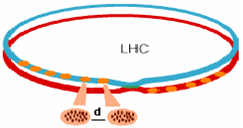Taking a closer look at LHC
Eeach bunch travels at almost the speed of light (v = 0,999999991·c ) :
v = 0,999999991 x 299792458 ⇒ v = 299792455 m/s
So each one will go around
299792455 / 26659 = 11245 laps per second
During the 20 minutes needed to reach the final energy, the protons cover a distance further than from Earth to the Sun and back.
11245 x 20 x 60 x 27 = 3.64·108 km
The Frequency of the circular movement already calculated is: f = 11,245 kHz
|
Protons will be accelerated to v~c. While travelling they will permanently be under a centripetal acceleration produced by Lorentz Force. Let´s calculate this centripetal acceleration: a ≈ c2/r ⇒ ac ≈ 2.3·1013 m/s2 Therefore 2·1012 times the acceleration of gravity.
|
 |
|
It's been said before that the distance between the two bunches will be: d = 7, 48 m So the “time between bunches” -bunch spacing- will be
t = distance / velocity t = 24,95·10-9 s ⇒ t = 24,95 ns
which is a very important parameter.
|
 |
Another interesting exercise is to calculate how many laps the protons travel before falling due to gravity.
|
h = ½g·t2 ⇒ t = (2h/g)1/2 where h is the pipe radius (~ 28 mm)
so: t = (2·0,028/9,81)1/2 t ≈ 76 ms Divided by the period:
nº of laps = 76·10-3/8,9·10-5 n = 850 laps |
 |
Therefore, we must not only correct the electromagnetic alterations but we must also correct those due to gravity. The magnetic multipoles will correct those alterations.
|
AUTHORS Xabier Cid Vidal, PhD in experimental Particle Physics for Santiago University (USC). Research Fellow in experimental Particle Physics at CERN from January 2013 to Decembre 2015. He was until 2022 linked to the Department of Particle Physics of the USC as a "Juan de La Cierva", "Ramon y Cajal" fellow (Spanish Postdoctoral Senior Grants), and Associate Professor. Since 2023 is Senior Lecturer in that Department.(ORCID). Ramon Cid Manzano, until his retirement in 2020 was secondary school Physics Teacher at IES de SAR (Santiago - Spain), and part-time Lecturer (Profesor Asociado) in Faculty of Education at the University of Santiago (Spain). He has a Degree in Physics and a Degree in Chemistry, and he is PhD for Santiago University (USC) (ORCID). |
CERN CERN Experimental Physics Department CERN and the Environment |
LHC |
IMPORTANT NOTICE
For the bibliography used when writing this Section please go to the References Section
© Xabier Cid Vidal & Ramon Cid - rcid@lhc-closer.es | SANTIAGO (SPAIN) |



